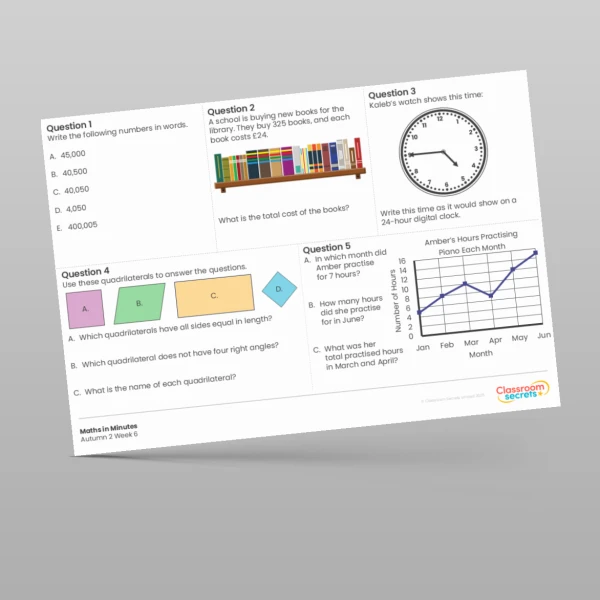

This Year 5 Maths in Minutes resource is designed to promote quick recall and retrieval of children's knowledge and prior learning, recapping a number of objectives from across Year 5 such as ordering 7-digit numbers, calculating the area of rectangles to compare them and solving problems involving converting between units of time.
There are three sets of five questions that cover a variety of maths skills in the areas of number, calculation, measure, geometry, statistics and fractions. This activity is perfect to use during registration, at the start of a maths lesson or whenever you have some time to spare. We've specially designed this resource to be displayed on the interactive whiteboard to save on printing costs. Try it today!
Curriculum Objectives
- Read, write, order and compare numbers to at least 1,000,000
- Interpret negative numbers in context, count forwards and backwards with positive and negative whole numbers, including through zero
- Add and subtract whole numbers with more than 4 digits, including using formal written methods (columnar addition and subtraction)
- Multiply numbers up to 4 digits by a one- or two-digit number using a formal written method, including long multiplication for two-digit numbers
- Solve problems involving multiplication and division including using their knowledge of factors and multiples, squares and cubes
- Add and subtract fractions with the same denominator and denominators that are multiples of the same number
- Solve problems which require knowing percentage and decimal equivalents of 1/2 , 1/4 , 1/5 , 2/5 , 4/5 and those fractions with a denominator of a multiple of 10 or 25
- Solve problems involving converting between units of time
- Convert between different units of metric measure (for example, kilometre and metre; centimetre and metre; centimetre and millimetre; gram and kilogram; litre and millilitre)
- Calculate and compare the area of rectangles (including squares), and including using standard units, square centimetres (cm2) and square metres (m2) and estimate the area of irregular shapes
- Distinguish between regular and irregular polygons based on reasoning about equal sides and angles
- Know angles are measured in degrees: estimate and compare acute, obtuse and reflex angles
- Identify angles at a point and one whole turn (total 360), angles at a point on a straight line and 1/2 a turn (total 180 ) and other multiples of 90
- Complete, read and interpret information in tables, including timetables
- Solve comparison, sum and difference problems using information presented in a line graph
Tags
Summer
5N2
5N5
5C2
5C7a
5C8a
5F4
5F12
5M4
5M5
5M7b
5G2b
5G4a
5G4b
5S1
5S2
Maths in Minutes











